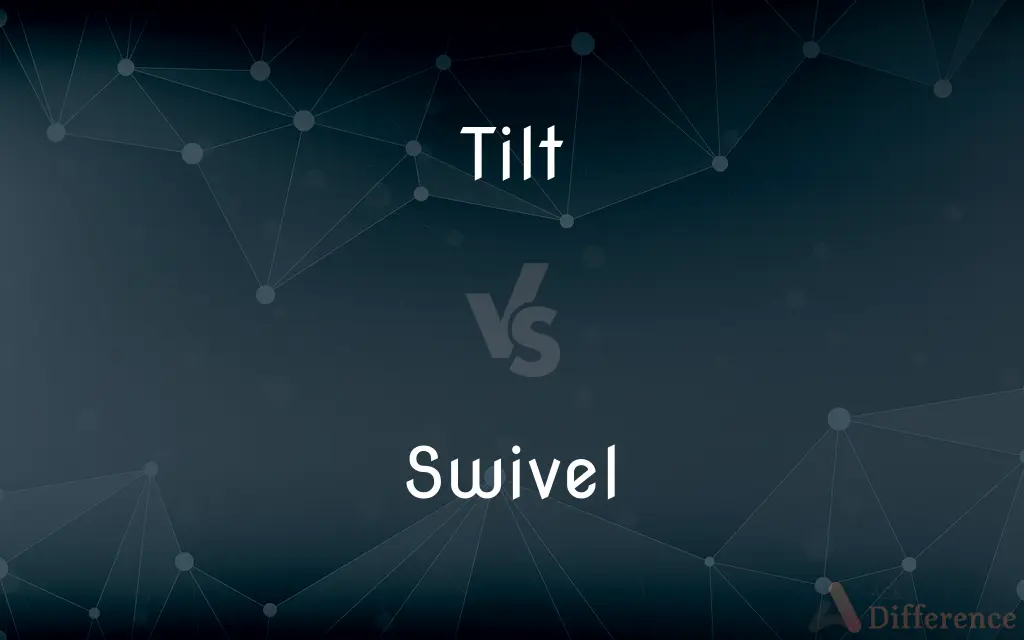Tilt vs. Swivel — What's the Difference?
Edited by Tayyaba Rehman — By Maham Liaqat — Updated on April 23, 2024
"Tilt" refers to the motion of moving an object along its horizontal axis, while "swivel" involves rotating around a vertical axis.

Difference Between Tilt and Swivel
Table of Contents
ADVERTISEMENT
Key Differences
Tilt allows an object to be moved forward or backward around a horizontal hinge or pivot point, enhancing viewing angles or ergonomic comfort, whereas swivel enables the object to rotate 360 degrees, providing all-around flexibility.
In ergonomic chair design, the tilt function adjusts the angle of the seat or backrest, which can reduce strain on the spine, while the swivel function allows the chair to rotate, facilitating easy access to various parts of a workspace without moving the base of the chair.
Computer monitors with tilt adjustments help users optimize screen angles to minimize glare and improve sight lines, while swivel adjustments allow users to share their screen with others or reposition the monitor quickly as needed.
Camera tripods often feature both tilt and swivel capabilities; tilt adjustments are crucial for achieving the correct vertical angle for a shot, whereas swivel adjustments are used for panoramic views or tracking moving subjects.
In the context of machinery, tilt mechanisms are used to change the orientation of a tool or workpiece, important for tasks such as custom cutting or assembly, while swivel mechanisms allow for complete rotational movement, which is essential for tasks requiring versatility and reach.
ADVERTISEMENT
Comparison Chart
Motion Type
Moves forward or backward
Rotates around vertical axis
Axis
Horizontal
Vertical
Common Uses
Ergonomic adjustments, camera angles
Chair movement, panoramic camera shots
Purpose
Reduces strain, optimizes viewing angles
Increases accessibility, enhances flexibility
Industry Example
Ergonomic chairs, camera tripods
Office chairs, camera tripods
Compare with Definitions
Tilt
A mechanism allowing angular movement on a horizontal plane.
The new laptop stand has an enhanced tilt feature for better viewing.
Swivel
The action or process of spinning or turning on an axis.
The mechanic used a swivel to reach the engine parts.
Tilt
To incline or slope an object.
Tilt the screen to avoid the overhead light reflection.
Swivel
A rotating device that connects two parts allowing rotation.
The camera's swivel base makes it ideal for video conferencing.
Tilt
The act of leaning or tilting something.
Tilt the painting slightly upwards to catch the light.
Swivel
To turn around a point or pivot.
Swivel the chair to face the door.
Tilt
The degree of inclination relative to a horizontal plane.
Measure the tilt of the roof to ensure proper drainage.
Swivel
A fastener that allows something to rotate freely.
The swivel hook is essential for the hanging plant's movement.
Tilt
To cause to lean, incline, slope, or slant.
Tilt the umbrella towards the wind to avoid it being blown away.
Swivel
To rotate or revolve with ease.
Swivel the monitor when sharing your screen during the presentation.
Tilt
Move or cause to move into a sloping position
The floor tilted slightly
He tilted his head to one side
Swivel
A swivel is a connection that allows the connected object, such as a gun, chair, swivel caster, or an anchor rode to rotate horizontally or vertically.
Tilt
(in jousting) thrust at with a lance or other weapon
The lonely hero tilting at the system
He tilts at his prey
Swivel
A coupling between two parts enabling one to revolve without turning the other.
Tilt
A sloping position or movement
The tilt of her head
Swivel
Turn around a point or axis or on a swivel
He swivelled in the chair
She swivelled her eyes round
Tilt
A combat for exercise or sport between two men on horseback with lances; a joust.
Swivel
A device that joins two parts in a way that allows one part to turn without turning the other.
Tilt
A small hut in a forest.
Swivel
To turn or rotate on a swivel or an axis.
Tilt
To cause to slope, as by raising one end; incline
Tilt a soup bowl.
Tilt a chair backward.
Swivel
To secure, fit, or support with a swivel.
Tilt
To cause to be advantageous to one party rather than another
A development that tilted the balance of trade in their favor.
Swivel
To turn on a swivel or an axis.
Tilt
To aim or thrust (a lance) in a joust.
Swivel
(mechanical) A piece, such as a ring or hook, attached to another piece by a pin, in such a manner as to permit rotation about the pin as an axis.
Tilt
To charge (an opponent); attack.
Swivel
(military) A small piece of ordnance, turning on a point or swivel; called also swivel gun.
Tilt
To forge with a tilt hammer.
Swivel
Strength of mind or character that enables one to overcome adversity; confidence; force of will.
Bob ain't got no swivel.
Tilt
To slope; incline
The field tilts toward the river.
Swivel
The act of swivelling.
Tilt
To have a preference, favor, or be inclined toward something
She recently tilted toward vegetarianism.
Swivel
(dance) A rotating of the hips.
Tilt
To be advantageous to one side over another, as in a dispute
"The battle ... was beginning to tilt again in the Confederates' favor" (Stephen W. Sears).
Swivel
(fishing) A small, usually ball- or barrel-shaped device used in angling to connect sections of fishing lines, consisting of two rings linked via a thrust bearing pivot joint.
Tilt
To fight with lances; joust.
Swivel
(intransitive) To swing or turn, as on a pin or pivot.
Tilt
To engage in a combat or struggle; fight
Tilting at injustices.
Swivel
A piece, as a ring or hook, attached to another piece by a pin, in such a manner as to permit rotation about the pin as an axis.
Tilt
To cover (a vehicle) with a canopy or an awning.
Swivel
A small piece of ordnance, turning on a point or swivel; - called also swivel gun.
Tilt
The act of tilting or the condition of being tilted.
Swivel
To swing or turn, as on a pin or pivot.
Tilt
An inclination from the horizontal or vertical; a slant
Adjusting the tilt of a writing table.
Swivel
A coupling (as in a chain) that has one end that turns on a headed pin
Tilt
A sloping surface, as of the ground.
Swivel
Turn on a pivot
Tilt
A tendency to favor one side in a dispute
The court's tilt toward conservative rulings.
Tilt
A preference, inclination, or bias
"pitilessly illuminates the inaccuracies and tilts of the press" (Nat Hentoff).
Tilt
A medieval sport in which two mounted knights with lances charged together and attempted to unhorse one another.
Tilt
A thrust or blow with a lance.
Tilt
A combat, especially a verbal one; a debate.
Tilt
A tilt hammer.
Tilt
New England See seesaw.
Tilt
A canopy or an awning for a boat, wagon, or cart.
Tilt
(transitive) To slope or incline (something); to slant.
Tilt the barrel to pour out its contents.
Tilt
(intransitive) To be at an angle.
Tilt
To charge (at someone) with a lance.
Tilt
(transitive) To point or thrust a weapon at.
Tilt
(transitive) To point or thrust (a weapon).
Tilt
To forge (something) with a tilt hammer.
To tilt steel in order to render it more ductile
Tilt
To intentionally let the ball fall down to the drain by disabling flippers and most targets, done as a punishment to the player when the machine is nudged too violently or frequently.
Tilt
To play worse than usual (often as a result of previous bad luck or losses).
Tilt
(transitive) To cover with a tilt, or awning.
Tilt
A slope or inclination.
Tilt
The inclination of part of the body, such as backbone, pelvis, head, etc.
Tilt
(photography) The controlled vertical movement of a camera, or a device to achieve this.
Tilt
A jousting contest. (countable)
Tilt
An attempt at something, such as a tilt at public office.
Tilt
A thrust, as with a lance.
Tilt
A tilt hammer.
Tilt
A canvas covering for carts, boats, etc.
Tilt
Any covering overhead; especially, a tent.
Tilt
A covering overhead; especially, a tent.
Tilt
The cloth covering of a cart or a wagon.
Tilt
A cloth cover of a boat; a small canopy or awning extended over the sternsheets of a boat.
Tilt
A thrust, as with a lance.
Tilt
A military exercise on horseback, in which the combatants attacked each other with lances; a tournament.
Tilt
See Tilt hammer, in the Vocabulary.
Tilt
Inclination forward; as, the tilt of a cask.
Tilt
To cover with a tilt, or awning.
Tilt
To incline; to tip; to raise one end of for discharging liquor; as, to tilt a barrel.
Tilt
To point or thrust, as a lance.
Sons against fathers tilt the fatal lance.
Tilt
To point or thrust a weapon at.
Tilt
To hammer or forge with a tilt hammer; as, to tilt steel in order to render it more ductile.
Tilt
To run or ride, and thrust with a lance; to practice the military game or exercise of thrusting with a lance, as a combatant on horseback; to joust; also, figuratively, to engage in any combat or movement resembling that of horsemen tilting with lances.
He tiltsWith piercing steel at bold Mercutio's breast.
Swords out, and tilting one at other's breast.
But in this tournament can no man tilt.
The fleet, swift tilting, o'er the urges flew.
Tilt
To lean; to fall partly over; to tip.
The trunk of the body is kept from tilting forward by the muscles of the back.
Tilt
A combat between two mounted knights tilting against each other with blunted lances
Tilt
A contentious speech act; a dispute where there is strong disagreement;
They were involved in a violent argument
Tilt
A slight but noticeable partiality;
The court's tilt toward conservative rulings
Tilt
The property possessed by a line or surface that departs from the vertical;
The tower had a pronounced tilt
The ship developed a list to starboard
He walked with a heavy inclination to the right
Tilt
Pitching dangerously to one side
Tilt
To incline or bend from a vertical position;
She leaned over the banister
Tilt
Heel over;
The tower is tilting
The ceiling is slanting
Tilt
Move sideways or in an unsteady way;
The ship careened out of control
Tilt
Charge with a tilt
Common Curiosities
What is the advantage of swivel in office chairs?
Swivel allows the chair to rotate, enhancing mobility within the workspace.
What does swivel mean?
Swivel refers to the rotation of an object around a vertical axis.
Can a device have both tilt and swivel functions?
Yes, many devices, like office chairs and camera tripods, feature both.
Are tilt and swivel mechanisms expensive to add to equipment?
The cost can vary, but these features generally add value and functionality to equipment.
Why is swivel important in cameras?
Swivel allows for a wide range of motion, facilitating panoramic shots and quick repositioning.
Is swivel functionality useful in industrial machinery?
Yes, it allows machinery to access different areas without moving its base.
How does tilt improve monitor usability?
By adjusting the monitor's angle, tilt helps in reducing glare and improving visibility.
How do tilt mechanisms affect the ergonomics of a workstation?
They allow for better adjustment to individual user needs, enhancing comfort.
What type of maintenance is required for tilt and swivel mechanisms?
Regular lubrication and checking for wear and tear are recommended.
What does tilt mean in terms of motion?
Tilt refers to moving an object around its horizontal axis.
What is the primary benefit of tilt in ergonomic chairs?
Tilt adjustments help in reducing back strain by altering sitting angles.
Can tilt and swivel features be locked for stability?
Yes, many models allow these features to be locked when stability is needed.
Which motion would be more beneficial for a video gamer?
Both tilt and swivel offer benefits, but swivel might offer better overall flexibility.
What should be considered when buying a swivel chair?
Consider the range of rotation and ease of movement.
How do I decide between tilt and swivel for specific applications?
Consider the primary need for motion angular adjustment or rotational flexibility.
Share Your Discovery

Previous Comparison
Disclose vs. Reveal
Next Comparison
Aqua vs. TealAuthor Spotlight
Written by
Maham LiaqatEdited by
Tayyaba RehmanTayyaba Rehman is a distinguished writer, currently serving as a primary contributor to askdifference.com. As a researcher in semantics and etymology, Tayyaba's passion for the complexity of languages and their distinctions has found a perfect home on the platform. Tayyaba delves into the intricacies of language, distinguishing between commonly confused words and phrases, thereby providing clarity for readers worldwide.














































